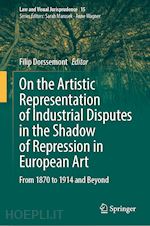
Questo prodotto usufruisce delle SPEDIZIONI GRATIS
selezionando l'opzione Corriere Veloce in fase di ordine.
Pagabile anche con Carta della cultura giovani e del merito, 18App Bonus Cultura e Carta del Docente
This book is the first volume on the artistic representation of industrial disputes in European art (from 1870 to 1914) since the catalogue of the landmark exhibition Streik, Realität und Mythos, organized by the Deutsches Historisches Museum (1992). It has been written by a group of scholars who share a keen interest in social history and the history of art, as well as in-depth knowledge of industrial relations and collective labour law.
Seeking to transcend a purely western European perspective, the book offers unprecedented insights into artistic production in Poland and Hungary from the 19th century to the communist era. It even goes beyond the European continent, examining the United States and Mexico.
The media explored include painting, sculpture, the graphic arts and photography. Further, the book deals with artists great (Carlo Carrà, Walter Crane, James Ensor, Juan Gris, Käthe Kollwitz, Constantin Meunier,Mihály Munkácsy, Théophile-Alexandre Steinlen and Jan Toorop) and small, sometimes even anonymous. The artistic styles range from (social) realism, naturalism and neo-impressionism to futurism and socialist realism.
All stages of industrial disputes (from the causes of strikes to their violent suppression) are subjected to iconographical and iconological analysis, combined with perspectives from visual studies, critical art and gender studies. Agricultural workers, miners, construction workers and textile workers fill the scenes. Most of them are subordinate workers; others are (bogus) independent workers and migrant workers.
Given its scope, the book will be of interest to (art) historians, labour law scholars, and specialists in industrial relations.
Introduction.- Some perspectives on the representation of industrial disputes under the shadow of repression in European Art (1870-1914).- Early Stages of Collective Action and their Visual Representations: an Emotions Driven Approach to the Struggle for Better Working Conditions.- The Midinette guiding the People. An iconographic break of the Assiette au Beurre.- Labour and Art: The dualism of backwardness and timeliness in Hungary and in its Eastern neighbourhood.- From 1844 to 1944 - Workers and revolutions in Poland.- Conclusions.
Prof. Dr. Filip Dorssemont is full professor of Labour Law at the Faculty of Law of the UCLouvain (in Louvain-La-Neuve). He is the President of the School of Labour Sciences (UCLouvain) and member of the Transnational Trade Union Rights Expert Network (European Trade Union Institute). Filip Dorssemont has read law (Antwerp University, Master in Law 1993), studied philosophy (bachelor Antwerp University 1990, and a Complementary Studies in Philosophy at the Institute of Philosophy, Leuven University, 1994). In 2001 he defended a Ph.D. thesis in law. In 2023 he obtained a Master in History of Art (UCLouvain).











Il sito utilizza cookie ed altri strumenti di tracciamento che raccolgono informazioni dal dispositivo dell’utente. Oltre ai cookie tecnici ed analitici aggregati, strettamente necessari per il funzionamento di questo sito web, previo consenso dell’utente possono essere installati cookie di profilazione e marketing e cookie dei social media. Cliccando su “Accetto tutti i cookie” saranno attivate tutte le categorie di cookie. Per accettare solo deterninate categorie di cookie, cliccare invece su “Impostazioni cookie”. Chiudendo il banner o continuando a navigare saranno installati solo cookie tecnici. Per maggiori dettagli, consultare la Cookie Policy.